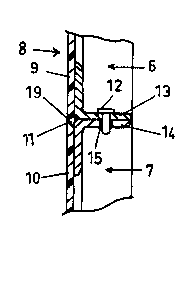Une partie des informations de ce site Web a été fournie par des sources externes. Le gouvernement du Canada n'assume aucune responsabilité concernant la précision, l'actualité ou la fiabilité des informations fournies par les sources externes. Les utilisateurs qui désirent employer cette information devraient consulter directement la source des informations. Le contenu fourni par les sources externes n'est pas assujetti aux exigences sur les langues officielles, la protection des renseignements personnels et l'accessibilité.
L'apparition de différences dans le texte et l'image des Revendications et de l'Abrégé dépend du moment auquel le document est publié. Les textes des Revendications et de l'Abrégé sont affichés :
| (12) Demande de brevet: | (11) CA 2182892 |
|---|---|
| (54) Titre français: | PAROI LATERALE DE RECIPIENT |
| (54) Titre anglais: | CONTAINER SIDE |
| Statut: | Réputée abandonnée et au-delà du délai pour le rétablissement - en attente de la réponse à l’avis de communication rejetée |
| (51) Classification internationale des brevets (CIB): |
|
|---|---|
| (72) Inventeurs : |
|
| (73) Titulaires : |
|
| (71) Demandeurs : |
|
| (74) Agent: | SMART & BIGGAR LP |
| (74) Co-agent: | |
| (45) Délivré: | |
| (86) Date de dépôt PCT: | 1995-12-13 |
| (87) Mise à la disponibilité du public: | 1996-06-20 |
| Licence disponible: | S.O. |
| Cédé au domaine public: | S.O. |
| (25) Langue des documents déposés: | Anglais |
| Traité de coopération en matière de brevets (PCT): | Oui |
|---|---|
| (86) Numéro de la demande PCT: | PCT/AU1995/000840 |
| (87) Numéro de publication internationale PCT: | WO 1996018547 |
| (85) Entrée nationale: | 1996-08-07 |
| (30) Données de priorité de la demande: | ||||||
|---|---|---|---|---|---|---|
|
Paroi latérale (1) de récipient composée d'une partie supérieure (6) et d'une partie inférieure (7) jointes l'une à l'autre par une charnière (19), de sorte que la partie supérieure peut pivoter par rapport à la partie inférieure. Pour éliminer de façon sensible les charges de pression, telles que celle exercée sur la charnière par la charge contenue dans le récipient dont la paroi latérale est un des éléments, des moyens (12, 15) de résistance à la charge sont placés dans les parties supérieure et inférieure, afin d'en joindre les côtés adjacents. Au moment de la jointure de la partie (6) avec la partie (7), on passe de la phase de chargement, dans laquelle les parties (6, 7) sont l'une sur l'autre, à la phase d'utilisation, dans laquelle elles sont coplanaires. Les moyens (14, 15) de résistance à la charge s'engagent automatiquement lorsque les parties latérales (6, 7) se placent dans la phase d'utilisation, et se dégagent automatiquement lorsque la partie supérieure (6) pivote sur la partie inférieure pour sortir de cette phase d'utilisation dans laquelle les deux parties sont coplanaires.
A container side having an upper part (6) and a lower part (7) hinged
together by a hinge (19) so the upper part can pivot relative to the lower part.To substantially eliminate pressure loads on the hinge as are exerted by the load
within the container of which the side is an element, load resisting means (12,
15) are provided to couple adjacent sides of the upper and lower parts. In a
hinging sequence of the upper part (6) relative to the lower part (7) from a
loading condition where the parts (6, 7) are overlying to an operational condition
where they are coplanar, the load resisting means (12, 15) will automatically
engage when the side parts (6, 7) approach the operational condition and will
automatically disengage when the upper part (6) is hinged from the coplanar
operational condition.
Note : Les revendications sont présentées dans la langue officielle dans laquelle elles ont été soumises.
Note : Les descriptions sont présentées dans la langue officielle dans laquelle elles ont été soumises.

2024-08-01 : Dans le cadre de la transition vers les Brevets de nouvelle génération (BNG), la base de données sur les brevets canadiens (BDBC) contient désormais un Historique d'événement plus détaillé, qui reproduit le Journal des événements de notre nouvelle solution interne.
Veuillez noter que les événements débutant par « Inactive : » se réfèrent à des événements qui ne sont plus utilisés dans notre nouvelle solution interne.
Pour une meilleure compréhension de l'état de la demande ou brevet qui figure sur cette page, la rubrique Mise en garde , et les descriptions de Brevet , Historique d'événement , Taxes périodiques et Historique des paiements devraient être consultées.
| Description | Date |
|---|---|
| Inactive : CIB de MCD | 2006-03-12 |
| Le délai pour l'annulation est expiré | 1999-12-13 |
| Demande non rétablie avant l'échéance | 1999-12-13 |
| Réputée abandonnée - omission de répondre à un avis sur les taxes pour le maintien en état | 1998-12-14 |
| Demande publiée (accessible au public) | 1996-06-20 |
| Date d'abandonnement | Raison | Date de rétablissement |
|---|---|---|
| 1998-12-14 |
Le dernier paiement a été reçu le 1997-11-28
Avis : Si le paiement en totalité n'a pas été reçu au plus tard à la date indiquée, une taxe supplémentaire peut être imposée, soit une des taxes suivantes :
Veuillez vous référer à la page web des taxes sur les brevets de l'OPIC pour voir tous les montants actuels des taxes.
| Type de taxes | Anniversaire | Échéance | Date payée |
|---|---|---|---|
| TM (demande, 2e anniv.) - petite | 02 | 1997-12-15 | 1997-11-28 |
Les titulaires actuels et antérieures au dossier sont affichés en ordre alphabétique.
| Titulaires actuels au dossier |
|---|
| LADISLAV STEPHAN KARPISEK |
| Titulaires antérieures au dossier |
|---|
| S.O. |